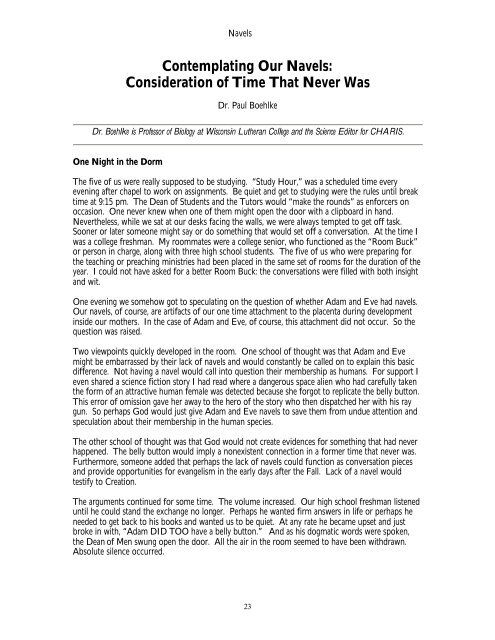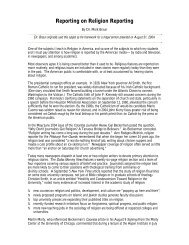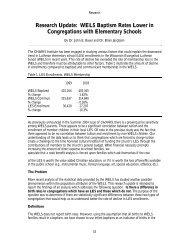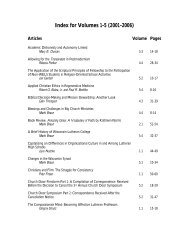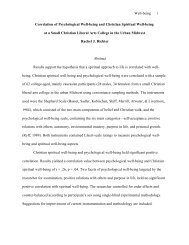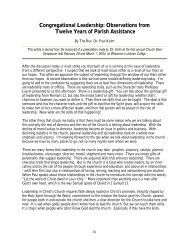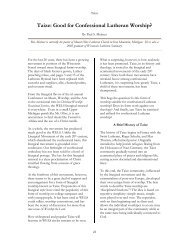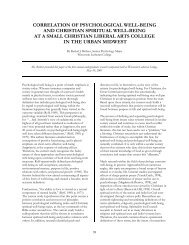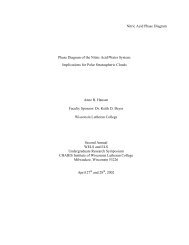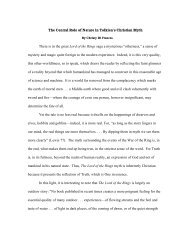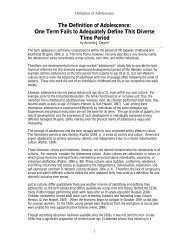Contemplating Our Navels: Consideration of Time That Never Was
Contemplating Our Navels: Consideration of Time That Never Was
Contemplating Our Navels: Consideration of Time That Never Was
Create successful ePaper yourself
Turn your PDF publications into a flip-book with our unique Google optimized e-Paper software.
<strong>Navels</strong><br />
<strong>Contemplating</strong> <strong>Our</strong> <strong>Navels</strong>:<br />
<strong>Consideration</strong> <strong>of</strong> <strong>Time</strong> <strong>That</strong> <strong>Never</strong> <strong>Was</strong><br />
Dr. Paul Boehlke<br />
Dr. Boehlke is Pr<strong>of</strong>essor <strong>of</strong> Biology at Wisconsin Lutheran College and the Science Editor for CHARIS.<br />
One Night in the Dorm<br />
The five <strong>of</strong> us were really supposed to be studying. “Study Hour,” was a scheduled time every<br />
evening after chapel to work on assignments. Be quiet and get to studying were the rules until break<br />
time at 9:15 pm. The Dean <strong>of</strong> Students and the Tutors would “make the rounds” as enforcers on<br />
occasion. One never knew when one <strong>of</strong> them might open the door with a clipboard in hand.<br />
<strong>Never</strong>theless, while we sat at our desks facing the walls, we were always tempted to get <strong>of</strong>f task.<br />
Sooner or later someone might say or do something that would set <strong>of</strong>f a conversation. At the time I<br />
was a college freshman. My roommates were a college senior, who functioned as the “Room Buck”<br />
or person in charge, along with three high school students. The five <strong>of</strong> us who were preparing for<br />
the teaching or preaching ministries had been placed in the same set <strong>of</strong> rooms for the duration <strong>of</strong> the<br />
year. I could not have asked for a better Room Buck: the conversations were filled with both insight<br />
and wit.<br />
One evening we somehow got to speculating on the question <strong>of</strong> whether Adam and Eve had navels.<br />
<strong>Our</strong> navels, <strong>of</strong> course, are artifacts <strong>of</strong> our one time attachment to the placenta during development<br />
inside our mothers. In the case <strong>of</strong> Adam and Eve, <strong>of</strong> course, this attachment did not occur. So the<br />
question was raised.<br />
Two viewpoints quickly developed in the room. One school <strong>of</strong> thought was that Adam and Eve<br />
might be embarrassed by their lack <strong>of</strong> navels and would constantly be called on to explain this basic<br />
difference. Not having a navel would call into question their membership as humans. For support I<br />
even shared a science fiction story I had read where a dangerous space alien who had carefully taken<br />
the form <strong>of</strong> an attractive human female was detected because she forgot to replicate the belly button.<br />
This error <strong>of</strong> omission gave her away to the hero <strong>of</strong> the story who then dispatched her with his ray<br />
gun. So perhaps God would just give Adam and Eve navels to save them from undue attention and<br />
speculation about their membership in the human species.<br />
The other school <strong>of</strong> thought was that God would not create evidences for something that had never<br />
happened. The belly button would imply a nonexistent connection in a former time that never was.<br />
Furthermore, someone added that perhaps the lack <strong>of</strong> navels could function as conversation pieces<br />
and provide opportunities for evangelism in the early days after the Fall. Lack <strong>of</strong> a navel would<br />
testify to Creation.<br />
The arguments continued for some time. The volume increased. <strong>Our</strong> high school freshman listened<br />
until he could stand the exchange no longer. Perhaps he wanted firm answers in life or perhaps he<br />
needed to get back to his books and wanted us to be quiet. At any rate he became upset and just<br />
broke in with, “Adam DID TOO have a belly button.” And as his dogmatic words were spoken,<br />
the Dean <strong>of</strong> Men swung open the door. All the air in the room seemed to have been withdrawn.<br />
Absolute silence occurred.<br />
23
<strong>Navels</strong><br />
Now Dean Delmar Brick, who was also a pastor and a serious scholar <strong>of</strong> Latin who had studied in<br />
Rome, suffered no nonsense. I fully expected that he would surely severely discipline us and call us<br />
to repent. The respect that students had for the authority <strong>of</strong> teachers and pastors in the 1950s is<br />
more rare today. Back then our parents would support whatever would be declared by a teacher or<br />
person in authority (in loco parentis) and <strong>of</strong>ten even add more punishment. In what seemed an<br />
unending silence, we waited for a deserved scolding that would cut to the heart <strong>of</strong> our very reasons<br />
for our being at this school that prepared church workers. 1 The clock on my desk seemed to be<br />
running slower and ticking very loudly.<br />
The Dean cleared his voice, we turned, and he looked seriously at each <strong>of</strong> us, one by one. He was<br />
not smiling. We slowly turned back to our books and stared at them, pretending to study.<br />
Then suddenly, he merely said with firmness, “Carry on, gentlemen,” and spun around, closing the<br />
door behind him. We glanced at each other, waited until we thought that the Dean must be far<br />
down the hall, and then burst into a nervous laughter that relieved the tension. The timing could not<br />
have been more perfect to get us into trouble, but Dean Brick chose to ignore it. While we thanked<br />
God for the undeserved pardon, we could only wonder what the Dean must have thought at the silly<br />
sentence that greeted his entrance.<br />
A More Serious <strong>Consideration</strong><br />
At first, the issue <strong>of</strong> the existence <strong>of</strong> Adam and Eve’s navels may seem silly, but theologians and<br />
scientists have given the problem very serious thought. In the 19 th Century geologists were<br />
compiling evidences that they felt indicated that the world was older than the Scriptures seem to<br />
allow. Charles Darwin was greatly influenced by this. The layers <strong>of</strong> rock and the fossils found in<br />
them stirred thought in both scientists and theologians.<br />
An English contemporary <strong>of</strong> Darwin was Philip Henry Gosse (1810-1888). Gosse was the<br />
outstanding British naturalist <strong>of</strong> the time. His fame rested on his popular books and lectures on<br />
plants and animals. He visited Jamaica and wrote extensively on the birds. He has been credited<br />
with discovering ten new species and is considered to be the father <strong>of</strong> ornithology for the island. 2 He<br />
was also a lay preacher and took a turn at Sunday sermons while in Jamaica.<br />
Having been blessed in being able to visit Jamaica several times to teach and study, I felt that no<br />
Christian could experience the place, see all the creatures, and fail to give glory to God. 3 Finding<br />
that Gosse had written about Jamaica, I looked for expression <strong>of</strong> his faith and was not disappointed.<br />
We both saw everything as God’s work, and he honored the Creator several times as he wrote. At<br />
the end <strong>of</strong> A Naturalist’s Sojourn in Jamaica he closed with, “Great are Thy works, Jehovah! Infinite<br />
Thy power! What thought can measure Thee, or tongue relate Thee?” 4<br />
Gosse decided to take on the problem <strong>of</strong> the growing geological evidences for an older earth.<br />
Furthermore, Darwin is likely to have shared his pre-publication thoughts about natural selection<br />
with Gosse. While Darwin favored this older earth with gradual change to explain our biological<br />
origins, Gosse decided to accept both the Scriptural and the geological chronologies.<br />
In combining science and Scripture, Gosse proposed that the processes <strong>of</strong> nature were circular. For<br />
example, chickens come from eggs and eggs come from chickens without end. The act <strong>of</strong> creation<br />
by God, Gosse submitted, required breaking into such natural cycles. Gosse did not claim to know<br />
where God would begin, but in wisdom He would choose a given point. So when God made the<br />
first chicken, it would be implied that it had come from an egg. The egg was, <strong>of</strong> course, nonexistent.<br />
<strong>Never</strong>theless, all evidences and reason would point backwards to this non-egg by virtue <strong>of</strong> the nature<br />
<strong>of</strong> things. Today, we could add that some <strong>of</strong> the calcium in the bones <strong>of</strong> the chicken would have<br />
24
<strong>Navels</strong><br />
come from the nonexistent shell. When one begins a circle at any point and draws in a given<br />
direction, say clockwise, one cannot escape the implication <strong>of</strong> implied points that precede the starting<br />
point even if they have not been drawn. Gosse called such appearances <strong>of</strong> preexistence,<br />
“prochronological.” He presented many illustrations. For example, an adult hippopotamus needs to<br />
have teeth that become beveled by wear and tear. Good function <strong>of</strong> the teeth requires this.<br />
Accordingly, Gosse reasoned that when God made a hippo, He would make it with teeth that are<br />
already “aged” and beveled so that the creature could eat. The observed virtual wear and tear,<br />
however, would again imply a history that did not exist.<br />
Gosse decided that God must have treated the entire creation this way. The layers <strong>of</strong> rock and all the<br />
fossils were necessary evidences <strong>of</strong> events and creatures that never were. They are there because they<br />
are part <strong>of</strong> natural cycles, necessary for the present to be as it is. All evidences before Creation had<br />
no real existence in time...they were part <strong>of</strong> a prochronologial past that never was. Gosse said that<br />
God could not break into a circle without implying the natural history before that entry. God was<br />
not only creating a creature but the entire natural concept <strong>of</strong> the creature and all that was necessary<br />
for it to be. Hence, all <strong>of</strong> nature, according to Gosse, was filled with evidences <strong>of</strong> a preexistence that<br />
had never happened.<br />
So, the problem <strong>of</strong> Adam’s belly button is resolved for Gosse. He said yes to navels for Adam and<br />
Eve as part <strong>of</strong> breaking into the circle <strong>of</strong> life. Furthermore, if you were in the Garden <strong>of</strong> Eden and<br />
took a saw to a just created tree, it would have rings that indicated a past that never happened.<br />
Moreover, if God were to neglect such appearances <strong>of</strong> age, the “just created” would be different<br />
from the latecomers in both form and function. We would not be able to recognize many <strong>of</strong> the<br />
creatures as members <strong>of</strong> their species.<br />
So Gosse launched his thesis with a publisher: Omphalos: An Attempt to Untie the Geological Knot.<br />
Omphalos is Greek for navel. Gosse had very high hopes for the book with a silly title; in it both<br />
Scripture and geology would be preserved. 5<br />
A Negative Reception<br />
This was not to be. Gosse’s hopes were dashed. Theologians and scientists both rejected the<br />
Omphalos argument. The theologians claimed that the prochronological evidences made God tell<br />
falsehoods in nature. Furthermore, there were other ideas in the air at the time. Some held that the<br />
Creation story was only local to the Garden and the rest <strong>of</strong> the earth was older. Others argued the<br />
language <strong>of</strong> Scripture allowed a gap for a huge amount <strong>of</strong> time between the first verse <strong>of</strong> Genesis and<br />
the account <strong>of</strong> the Six Days. On the other hand, some thought that the Genesis “Days” must be<br />
eras. Further yet, some imagined that millions <strong>of</strong> years might have past before Adam sinned. They<br />
added the idea that Adam would not have aged before sin and that his final age <strong>of</strong> 930 years was only<br />
counted from his Fall. To add to the mix, apparently many others thought that things would just<br />
work out with more investigation and that there was no real problem. They did not need Gosse to<br />
panic and remind them <strong>of</strong> the problem.<br />
Moreover, scientists did not like the idea <strong>of</strong> studying things that had no existence even though Gosse<br />
claimed that this was as valuable as studying things in real time. He held that all investigations <strong>of</strong><br />
nature, whether real or virtual, would teach about the glory and wonder <strong>of</strong> God’s Creation.<br />
However, uniformitarianism and gradualism had been firmly established by Charles Lyell, another<br />
contempory <strong>of</strong> Darwin’s, as the prevailing assumptions in geology. This approach required that 1)<br />
present day geological understandings should be used to explain the phenomena in the past. 2)<br />
changes in nature are slow and relatively steady, and 3) natural laws are constant and eternal.<br />
Assumptions are everything in reasoning, and these assumptions drove explanations that fit into a<br />
longer real time. 6 While Gosse wanted a literal reading <strong>of</strong> Scripture, scientists wanted a literal<br />
25
<strong>Navels</strong><br />
“reading” <strong>of</strong> geology. Rejected by both the theological and scientific camps, Gosse was embarrassed<br />
and devastated.<br />
Ron Roizen has an interesting insight into the times in which Gosse lived. Roizen believes that<br />
Omphalos, which was available only two years before the Origin <strong>of</strong> the Species, was generally rejected<br />
because society was becoming increasingly secularized. The rejection <strong>of</strong> Omphalos, in essence, acted as<br />
a measure <strong>of</strong> how much English society had shifted toward a worldview without theological<br />
underpinnings. Gosse was still trying to make science serve theology. Many in society were not <strong>of</strong><br />
that mind. Both theologians and scientists held empirical science high in their system <strong>of</strong><br />
understanding. 7 Shortly, Darwin would push the shift in thinking harder.<br />
The Modern Rejection <strong>of</strong> Omphalos<br />
Philip Gosse fairs no better today. Stephen Jay Gould, a strong defender <strong>of</strong> evolution, wrote one <strong>of</strong><br />
his many essays on Gosse. 8 One difficulty with the Omphalos, writes Gould, is that not all <strong>of</strong> nature’s<br />
processes are cyclical. Gould maintained that natural selection drives nature in a linear direction. It is<br />
interesting to note that Lyell and many others in the 19 th Century had no problem with Gosse’s<br />
cycles. Lyell also believed in cycles. It is not so today. Current science believes in a “Big Bang”<br />
beginning and an ultra-violet death. No matter, the cycles, though dear to Gosse, are not required<br />
for a Creation with age.<br />
Gould followed with a second and more important reason to scientifically reject Gosse. He pointed<br />
out that Omphalos theory isn’t testable. It cannot be falsified and therefore is not scientific. Gould<br />
stated:<br />
But what is so desperately wrong with Omphalos? Only this really (and perhaps paradoxically):<br />
that we can devise no way to find out whether it is wrong – or for that matter, right. Omphalos<br />
is the classic example <strong>of</strong> an utterly untestable notion, for the world will look exactly the same in<br />
all its intricate detail whether fossils and strata are prochronic or products <strong>of</strong> an extended history.<br />
When we realize that Omphalos must be rejected for this methodological absurdity, not for any<br />
demonstrated factual inaccuracy, then we will understand science as a way <strong>of</strong> knowing….<br />
Science is a procedure for testing and rejection hypotheses, not a compendium <strong>of</strong> certain<br />
knowledge. Claims that can be proved incorrect lie within its domain (as false statements to be<br />
sure, but as proposals that meet the primary methodological criterion <strong>of</strong> testability). But theories<br />
that cannot be tested in principle are not part <strong>of</strong> science. Science is doing, not clever cogitation;<br />
we [scientists] reject Omphalos as useless, not wrong.<br />
Gould, <strong>of</strong> course, had all theology and Creation science in mind as also being outside <strong>of</strong> the realm <strong>of</strong><br />
science. Note well that science alone is judging what is acceptable. To be fair, many feel that<br />
macroevolutionary theory suffers the same fate. It too cannot be tested. There is no way to disprove<br />
evoltuion. 9<br />
Conclusion<br />
Lutherans assume that the Bible has plain meanings within the grasp <strong>of</strong> the layperson who faithfully<br />
studies it, considers the context, knows the historical/social setting, and understands the problems<br />
being addressed. This is a hallmark <strong>of</strong> the Reformation to put the Scriptures in the hands <strong>of</strong> the<br />
people. Gosse’s Creation with age idea remains attractive because he is defending a very<br />
straightforward understanding <strong>of</strong> the Genesis account, He does not have to argue for changing <strong>of</strong><br />
meanings <strong>of</strong> words or to propose possible additions to the time frame. He is also rightly putting<br />
Scripture above science. Clearly, Scripture does indicate a Creation with age. For examples, Adam<br />
and Eve appear at a virtual age at which they are self-sufficient. Shall we guess that their virtual ages<br />
26
<strong>Navels</strong><br />
were eighteen when their real ages were zero? Adam and Eve are also told to eat mature fruit from<br />
mature trees in the Garden. We also know from current biology that Eve’s just created ovaries<br />
needed to contain eggs that had virtually aged to the prophase I stage to begin the populating <strong>of</strong> the<br />
world. It would be implied that these eggs had been set aside and matured to that state when she<br />
was still inside her non-existent mother as is the case with other human females. In summary,<br />
appearances <strong>of</strong> built-in age would abound in the fresh Creation.<br />
The credit we have to grant to Gosse’s Omphalos is that in any discussion <strong>of</strong> instantaneous creation or<br />
any miracle, one cannot escape some degree <strong>of</strong> an appearance <strong>of</strong> time-events that never were.<br />
Martin Gardner, a well-known skeptic and no friend <strong>of</strong> arguments for Creation, wrote about Gosse’s<br />
proposal:<br />
This is not as ridiculous as it may seem at first. Consider, for example, the difficulties which face<br />
any believer in a six-day creation. Although it is possible to imagine Adam without a navel, it is<br />
difficult to imagine him without bones, hair, teeth, and fingernails. Yet all these features bear in<br />
them the evidence <strong>of</strong> past accretions <strong>of</strong> growth. In fact there is not an organ or tissue <strong>of</strong> the<br />
body which does not presuppose a previous growth history…. The same is true <strong>of</strong> every plant<br />
and animal. As Gosse points out, the tusks <strong>of</strong> an elephant exhibit past stages, the nautilus keeps<br />
adding chambers to its shell, the turtle adds laminae to its plates…. In short – if God created the<br />
earth as described in the Bible, he must have created it a “going concern.”<br />
Gardner concludes that Gosse’s argument, while not well received, was flawless. It preserves both<br />
theology and geology. He rates Gosse as making other Creationist arguments pale by comparison. 10<br />
Accordingly, what happens when science is applied to the Creation? The ruling assumptions will<br />
pr<strong>of</strong>oundly influence the conclusions. If the assumptions include uniformitarianism and also exclude<br />
anything supernatural, God will not be recognized. Virtual histories in a Creation with age could<br />
cause scientific dating methods to go astray. Even in other miracles in Scripture, when Jesus calms a<br />
storm, from a scientific viewpoint this implies going back into time and changing all the previous<br />
weather conditions to produce the calm. These would be conditions that never existed in real time.<br />
Similarly, changing water into wine implies a grapevine, making a mash, allowing fermentation by<br />
microbes to occur in time that never was. Extra loaves and fish would also have a nonexistent<br />
history that the reader can imagine. 11 One simply cannot apply science to miracles without<br />
puzzlement over time-events.<br />
Would God be guilty <strong>of</strong> lying to us and misleading us if virtual evidences existed in nature and<br />
implied an older earth or virtual processes? Some feel that this is a very important question. First,<br />
recognize that it is the elevation <strong>of</strong> human reason over Scripture that drives the question. Its source<br />
is a different spirit. There also would be present an extreme confidence in our ability to read the<br />
book <strong>of</strong> nature correctly to conclude that God is misleading us. Scripture must guide reason.<br />
Scripture tells us plainly that God created, and that needs to guide our thinking. We have to accept<br />
that everything we experience does somehow fit into what Scripture declares even if we fail to<br />
understand it in this life.<br />
Does Gosse’s Creation with age argument solve everything? No, it is an interesting idea and shows<br />
us a possibility, but questions will still remain. One might wonder why there are fossils in the<br />
geological record that seem to “dead end” and have no required connection to the present species.<br />
Why would they be required in virtual time? Furthermore, we should never tie our faith to any<br />
human reasoning. August Pieper stated, “…the laws <strong>of</strong> finite reason are not applicable to the<br />
infinite. We know in one way; God knows in all ways. We know mediately; God knows<br />
immediately. We know partially; God knows completely. We know very little, God knows all. We<br />
know one thing after the other; God knows all things at the same time.” 12<br />
27
<strong>Navels</strong><br />
Scripture is not a science book. The function <strong>of</strong> Scripture is to tell us how we can get to Heaven<br />
through faith in Jesus Christ, our Savior. As we are reminded in the Book <strong>of</strong> Job, we were not<br />
present at the Creation to observe it, and we cannot apply our reason and our science to this or any<br />
other miracle (Job 38: 4). <strong>Our</strong> science will not work when God uses unnatural means. We need to<br />
remind ourselves that Creation was a miracle. When we try to get beyond what Scripture states, we<br />
have to admit with Job that there are things “that are too wonderful” for us. If we make inferences<br />
from Scripture, we must be careful to recognize them as just that and never put them on the same<br />
level as God’s word. Gosse knew that and reminded his readers <strong>of</strong> the differences between God’s<br />
Word and the reasoning we do. 13 We need to be humble in these things and trust what God has told<br />
us. We can apply what Gosse said about his Omphalos theory to our general lack <strong>of</strong> knowledge<br />
about God’s ways <strong>of</strong> doing things: This may be a tough truth, but the truth is the truth. 14<br />
1 The location for the event was Dr. Martin Luther College, New Ulm, Minnesota. At the time a<br />
preparatory high school was on the campus with the college <strong>of</strong> education. Five students <strong>of</strong> mixed<br />
ages would share two rooms in the Men’s Dorm (now called Summit Hall): a bedroom and a study<br />
room.<br />
2 Philip H. Gosse. “Excerpts from The Birds <strong>of</strong> Jamaica in Gosse’s Jamaica.” in Gosse’s Jamaica. 1844-45<br />
D. B. Stewart Ed. Kingston: Institute <strong>of</strong> Jamaica, 1984, p. 182-183.<br />
3 Wisconsin Lutheran College, Martin Luther College, and Bethany College participate in a biennial<br />
Marine Ecology Course that is led by Dr. Robert Anderson <strong>of</strong> WLC during the Christmas break.<br />
4 Philip H. Gosse. “Excerpts from A Naturalist’s Sojourn in Jamaica” in Gosse’s Jamaica 1844-45 D. B.<br />
Stewart Ed. Kingston: Institute <strong>of</strong> Jamaica, 1984, p. 47.<br />
5 Philip H. Gosse. Omphalos: An Attempt to Untie the Geological Knot. (Originally published by J. Van<br />
Voorst, 1857) Woodbridge, VT: Ox Bow Press,1998 reprint.<br />
6 Lyell influenced Darwin pr<strong>of</strong>oundly. Darw in took the Bible and Lyell’s Geology text with him on<br />
the voyage <strong>of</strong> the Beagle.<br />
7 Ron Roizen. “The Rejection <strong>of</strong> Omphalos: A Note on Shifts in the Intellectual Hierarchy <strong>of</strong> Mid-<br />
Nineteenth Century Britain.” Journal for the Scientific Study <strong>of</strong> Religion, 21:365-369, 1982.<br />
<br />
8 Stephen Jay Gould. “Adam’s Navel” The Flamingo’s Smile: Reflections in Natural History. New York:<br />
Norton, 1985, 99-113. Gould may have been attracted to Gosse’s fate because <strong>of</strong> his own<br />
experiences. Gould who was one <strong>of</strong> the founders <strong>of</strong> punctuated equilibrium theory (where evolution<br />
varies its rate) is also guilty <strong>of</strong> violating the assumptions <strong>of</strong> uniformitarianism and gradualism.<br />
Hence, Gould, too, had also suffered much negative reception from other scientists and could<br />
appreciate Gosse’s situation.<br />
9 Birch L.C. & Ehrlich P.R., "Evolutionary History and Population Biology," Nature, Vol. 214, 22<br />
April 1967, 352. The authors state, "<strong>Our</strong> theory <strong>of</strong> evolution has become, as (Karl) Popper<br />
described, one which cannot be refuted by any possible observations. Every conceivable observation<br />
can be fitted into it. It is thus "outside <strong>of</strong> empirical science" but not necessarily false. No one can<br />
think <strong>of</strong> ways in which to test it. Ideas, either without basis or based on a few laboratory experiments<br />
carried out in extremely simplified systems, have attained currency far beyond their validity. They<br />
have become part <strong>of</strong> an evolutionary dogma accepted by most <strong>of</strong> us as part <strong>of</strong> our training." Note<br />
that philosopher Popper later changed his mind about this, but many still believe this is true.<br />
28
<strong>Navels</strong><br />
10 Martin Gardner. Fads and Fallacies In the Name <strong>of</strong> Science. New York: Dover, 1957, 125. Gardner<br />
entered the University <strong>of</strong> Chicago as a Christian. He rejected the theory <strong>of</strong> evolution following the<br />
arguments <strong>of</strong> George McCready Price, a Seventh-day Adventist creationist. A single course at<br />
Chicago in geology convinced him that Price was wrong. As a result he says that he quickly lost all<br />
faith in Christianity. The Flight <strong>of</strong> Peter Fromm. by Gardner is a semi-autobiographical novel that is<br />
based on this experience.<br />
11 Bernard. L. Ramm. The Christian View <strong>of</strong> Science and Scripture. Grand Rapids: Eerdmans, 1954, 194-<br />
195.<br />
12 August Pieper. “Scripture and Reason.” The Wauwatosa Theology, Curtis A. Jahn, Ed., Milwaukee:<br />
Northwestern, 1997, 164.<br />
13 Philip H. Gosse. Ibid., 372. Gosse states, “The conclusions hitherto received have been but<br />
inferences deduced from certain premises: the witness who reveals the premises does not testify to<br />
the inference.<br />
14 Philip H. Gosse. Ibid., 354.<br />
SESQUITERPENE*<br />
<strong>That</strong> we may know what God has done<br />
The Father, Spirit, and the Son<br />
He writes his name among His works –<br />
A set <strong>of</strong> five, and three in one.<br />
Sesquiterpene, farnesol<br />
Branch <strong>of</strong> carbons, simple, small<br />
When lily <strong>of</strong> the valley blooms<br />
Its scent will help us to recall<br />
<strong>That</strong> though the universe is grand –<br />
A testament to God’s command –<br />
The wonder lies in not just size,<br />
But in the details that He planned.<br />
-- Heidi Dahlmann<br />
*Heidi Dahlmann is a sophomore and a chemistry major at Wisconsin Lutheran College. The occasion for Heidi’s<br />
fine poetic effort was her reflection on a lecture in organic chemistry on terpenes given by Dr. Kevin Glaeske. Terpenes<br />
are the basis for many natural molecules that we sense as odors and are found as resins and essential oils (Glaeske).<br />
Farnesol is the scent found in the lily <strong>of</strong> the valley. Heidi’s reference to a “A set <strong>of</strong> five” is the five carbon unit called an<br />
isoprene unit. Three <strong>of</strong> these bond to form farnesol. A terpene molecule uses two <strong>of</strong> these units. Hence, farnesol is a<br />
sesquiterpene (SESS-queh-TER-peen) because it uses one and a half terpenes. At all levels <strong>of</strong> Creation, the<br />
Christian sees, reflects, and is reminded <strong>of</strong> the glory <strong>of</strong> God. – Paul Boehlke<br />
Glaeske, Kevin W. & Boehlke, Paul R. “Making Sense <strong>of</strong> Terpenes: An Exploration into Biological<br />
Chemistry.” The Aamerican Biology Teacher, March, 2002.<br />
29
.<br />
<strong>Navels</strong><br />
Lily <strong>of</strong> the Valley<br />
Farnesol<br />
(Lily <strong>of</strong> the Valley)<br />
MARK YOUR CALENDARS<br />
The Third Annual<br />
Church Door Symposium<br />
Will be held<br />
March 6 and 7, 2006<br />
30


